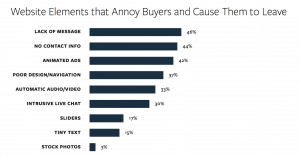
Customer questions create raw material for your company story
Build your company story by answering customers’ questions
When you lack a company story, everything about marketing grows a lot harder.
Without a company story, it’s harder to get customers on your website. The #1 reason people leave B2B websites is the lack of a message, research shows.

Without a good story, it’s harder to get support from influencers. If bloggers, news media and analysts don’t understand your company – why it exists and what it does to benefit customers – they won’t tell anyone else.
Without a good story, it’s harder to win attention in social media and word of mouth marketing. Unless your story is crystal-clear to your customers, they won’t bother to spread it to others.
Without a good story, it’s even harder to recruit and keep your employees. People want to be proud of their work and who they work for – so they can tell their friends.
If you don’t have a business story today, where should you begin?
Start with the questions your customers ask when they have a problem your company solves. Convene your leadership team and co-create answers to your customers’ questions.
From these answers, you can build a powerful 1-PageTM Message Map that tells your company story on just one page.
Always address your customers’ top question first: What’s in it for me? (WIIFM?)
Every customer, every stakeholder in your business is always looking for an answer to the WIIFM question.
Answering all your customers’ questions confidently and competently paves the way to a sale. How does your business story address your customers’ pain points, worries, problems and opportunities?
Whenever possible, capture the actual questions prospects and customers ask before they make a buying decision. Yes, I mean literally write down every customer question.
If one customer asks a question, 10 or 100 more customers may be wondering about the same thing, but they’re too reluctant to ask. That’s why customers who ask questions are so valuable in building your company story!
Capture customers’ questions verbatim.

Enlist employees and sales people to write down the questions they hear from customers on the phone, in retail shops, in email and on your website. Plug the questions into an Excel spreadsheet, then analyze them to find out:
- Which topics exactly do customers want to know more about?
- What are the key questions on your customers’ path to purchase?
- Which words do they use to describe their problem or need?
Customer questions are a treasure trove.
Customers will teach you which questions you need to answer in order for them to take the next step in the buyers’ journey. Answering key questions is crucial for you to become part of your customers’ considered set of solutions.
Customers search the Internet to answer their questions. When they Google their questions, will they find your answers?
Create the best answers on the Internet for your customers’ questions.
It’s crucial to offer the best answer available on the Internet to your customers’ questions; here’s why.
If you don’t, most of your content simply won’t matter to buyers. Marketers need to understand buyer personas before creating content.
One-on-one buyer persona research provides you deep insights that enable you to make sure your content is always relevant, speaks your customers’ language and addresses their information needs.
Below are questions to help you mine out the nuggets of information you’ll need when you start to create your company story on a 1-PageTM Message Map.
These questions range from simple questions that customers ask on impulse or transactional purchases to far more complex questions that arise with carefully considered purchases such as a car, home or investment plan.
On the business-to-business (B2B) side, information technology, infrastructure and capital facilities rank among the most carefully considered purchases.
Use the questions that apply to your customers and market. Skip what you don’t need.

Transactional purchase – customer questions
Hmm, I may have a problem. How big is the problem?
Do I need to make a change? Or can I live with the status quo?
What are the consequences if I don’t make a change?
Will this problem grow bigger if I don’t address it now? How big will it get? How much more will it cost to fix later, compared with fixing it now?
What exactly do I need to fix the problem?
Where does this problem hurt? What are my exact pain points? What do I hate the most about this situation?
Who else has a problem that looks just like mine? How do they solve it?
Does anyone have a product, service or solution that really addresses my problem? Or is my problem unsolved so far?
Where will I look for answers to my problem? Who can I consult with?
How hard is it to find a viable solution?
What do friends, family, customers, reviewers, analysts, bloggers, reporters and peers say about the problem and solution?
What are all the options available to solve the problem?
Who are all the sellers I would consider buying from?
How does this option compare with the other options? What are the advantages and disadvantages of each?
Which option performs best? Offers the best service? Best price? Best warranty? Best availability?
What recognition, awards or reviews has the seller gotten? Whose endorsements did they win?
Why should I trust this seller? Who’s had a good experience with them?
What regrets did other customers express about doing business with them?
If I buy this solution, how much time, money and/or grief will it really save me?
How much of a hassle will it be to implement?
How much will it cost? How much will it save?
Will it really make my life easier?

Carefully considered purchase – customer questions
Does this solution require changes to our business processes?
If we go through all the work to implement this solution, who will benefit?
Who supports making a change? Who actively opposes it? Who passively resists it?
How long will it take this purchase to prove out and achieve a pay-back?
Will it make my job easier? Will it make our team’s job easier? Will it make our business more successful?
Are our competitors changing how they do this? Are we falling behind? What do we need to do to catch up?
Where is this technology going in the future? Is it forward-compatible with the next generation, or will we have to rip it out and replace it? Is it evergreen technology?
Who are the top three vendors in the space? Out of all the vendors who could solve the problem, who’s the best?
How do I know that they’ll deliver what they promise?
How can I be sure this is the right decision? What’s at risk if it goes wrong?
Your customers have loads of questions.
It makes sense to collect your customer questions, understand them and address them proactively when you tell your company story.
Create a 1-Page Message Map to answer all your customers’ questions on just 1 page. A Message Map enables you to tell your company story and make it extremely relevant to customers by giving them what they want — good answers to their questions.
That’s the power you gain by building your company story on a Message Map!
Related Posts
“How do you keep content relevant?”
A marketer recently asked: “How do you keep content relevant? People get on to the next thing so fast and have lots of info...
Launching a product virtually? Read these tips
Tips for launching a product virtually. Autumn will be here soon. Time for changing leaves, pumpkin spice lattes, and product launches. Yes, product launches....
How to market successfully against competitors
Market successfully against competitors. One of our clients recently came under attack by its closest competitor. This competitor placed untrue claims about our client...
Why content marketing starts with customers’ needs
Content marketing doesn’t start with your products. It starts with your customers. That’s a lesson I learned from boxes of baking soda. More about that...





